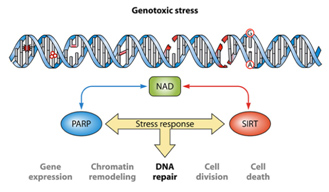I'm confused about some of the pathways involved here.
Over on AntiAging Firewalls, they claim that Niacin (Na) should be avoided, as it is all converted to Nicotinamide (Nam) in vivo (referencing the Wikipedia page on Nicotinamide), and Nam is a SIRT1 inhibitor, etc etc.
But the Wikipedia page on Niacin says there is no direct pathway for conversion of Na to Nam--and that matches with what I have read in various flowcharts pasted at this site.
What I see from the flowcharts are three possible pathways to NAD+. The Niacin pathway seems to be entirely independent:
Niacin (Na)--->NaMN--->NaAD--->NAD+
Both Nicotinamide and NR use a pathway that runs via NMN:
Nam--->NMN--->NAD+
NR--->NMN--->NAD+
NAD+ can of course be degraded to Nam (and recycled if there is enough NamPT around).
But it looks to me as if, on a molar basis, Niacin and NR both probably produce the same amount of free Nam.
Am I missing something? Does dosing with Niacin really produce more Nam per molecule than dosing with NR?
For that matter, do we know that NR is more effective than Niacin in raising NAD+?
I'm about to sit down to lunch so I'll be short. (Na) Niacin is dependent on the liver for conversion. So in large amounts it can become toxic, so there is reason for pause with this path. It also produces an intense flush and those of us with inflammatory skin conditions are not as tolerant as others to this, others are and some are seeking the raise their HDL ("good") cholesterol and Niacin will do that. The other 2 forms of B3 do not produce a flush and can be taken in much larger dosages as suggested before. Of these 2, nicotinamide riboside (NR) raises NAD levels the highest and some reports suggest nicotinamide (NAM) "the supplementation of (Nam) does not seem so effective in elevating cellular NAD contents beyond the basal level" study Revollo, J. R., Grimm, A. A., and Imai, S. (2004) J. Biol. Chem. 279, 50754–50763 There is much more to this and maybe this evening if you haven't found all the differences we can focus on them more deeply and get a discussion going.
Edited by Bryan_S, 13 June 2015 - 07:16 PM.































 This topic is locked
This topic is locked




























